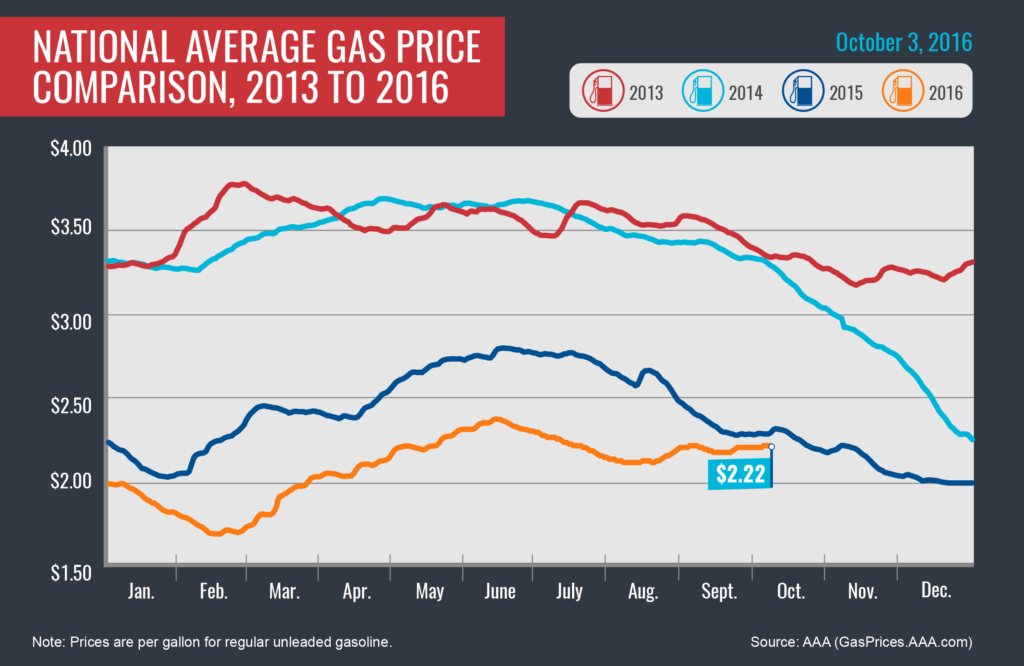Pump prices have climbed higher as compared to the previous week, even though many states have switched over to winter blend gasoline and there remain abundant crude oil supplies. The national average price for regular unleaded gasoline moved higher each of the past seven days reaching today’s average of $2.22 per gallon. Today’s average price is two cents more than one week ago and 1 cent more than one month ago. Despite the slight rise in pump prices, drivers continue to experience year-over-year savings with today’s average price about 7 cents per gallon less than the same date last year.

The national average has been relatively flat since September 3, and drivers in 21 states are paying less at the pump week-over-week. While national prices have been steady, pump prices in some regions have moved dramatically over this same period, largely due to disruptions on the Colonial Pipeline and refinery maintenance. As recently as last week, gas prices jumped in the Midwest as a result of scheduled and unscheduled maintenance at BP’s Whiting refinery impacting supply in the region. Drivers may continue to see pump prices wobble higher or lower in the next few weeks as the market reacts to the OPEC production agreement, continued refinery maintenance and a possible hurricane along the East Coast.
Quick Stats
- Average gas prices are below $2 per gallon in three states today including: New Jersey ($1.98), Texas ($1.98) and Missouri ($1.99).
- The biggest weekly price increases are reflected in Ohio (+14), Kentucky (+10), Indiana (+9), Louisiana (+5), Michigan (+5), Texas (+4), Illinois (+4), Iowa (+4), Arkansas (+4) Mississippi (+3).

West Coast
The West Coast continues to lead the nation, with the top six most expensive states located in the region: Hawaii ($2.81), California ($2.79), Washington ($2.71), Alaska ($2.63), Oregon ($2.52) and Nevada ($2.50). Recent reports from OPIS show gasoline supplies are slightly down from last week and production could continue to fall over the next few weeks as refineries move into their planned fall maintenance season.
Rockies
Gas prices in the Rocky Mountain states are relatively steady, moving by only +/- 3 cents on the week. Wyoming (-6 cents) is the only state posting a savings of a nickel or more on the month. Gas prices in the region are below the $2.50 per gallon benchmark, and some states are also seeing significant year-over-year savings with two making the list of top ten biggest yearly discounts: Utah (-38 cents), Wyoming (-35 cents).
Great Lakes and Central States
Pump prices in the Great Lakes region continue to be the most volatile in the nation. Drivers saw significant increases over the past week with four states in the region landing on the top ten list of biggest weekly increases: Ohio (+14 cents), Indiana (+9 cents), Michigan (+7 cents) and Illinois (+4 cents). The jump in price can likely be attributed to issues at BP’s Whiting refinery located in northwest Indiana. According to recent reports from OPIS, the refinery is still undergoing planned turnaround and unplanned maintenance related to problems with its largest crude distillation unit. The refinery is capable of producing 430,000 barrels of refined product per day, and the maintenance problems have created a noticeable impact on supply in the region.
Prices in the Central United States remain some of the cheapest in the country with three states in the region featured in the top 10 lowest: Missouri ($1.99), Oklahoma ($2.05) and Kansas ($2.06).

South and Southeast
Drivers are getting some relief from last month’s price spikes that resulted from problems on the Colonial Pipeline. Georgia (-4 cents) tops the list of largest weekly decreases with North Carolina (-3 cents), Tennessee (-3 cents) and South Carolina (-3 cents) also making the top 10. According to recent reports from OPIS, Colonial Pipeline has identified the location of the gasoline leak on Line 1 and is in the process of removing the impacted segment of the line. Once removed, the segment will be sent to an independent laboratory for analysis.
On September 21, Colonial Pipeline restarted full operations on Line 1 with the help of a 500-foot bypass. Gasoline deliveries are slowly reaching Southeast terminals and OPIS reports that it may take between one to two weeks for supply in the Southeast and Mid-Atlantic regions to return to normal.
Mid-Atlantic and Northeast
Northeast prices have remained steady with most states in the region landing on the list of top 15 smallest monthly changes. Price averages in the region have moved a penny or less over the past month.
Pump prices in most Mid-Atlantic states are starting to recover from unseasonal increases resulting from problems on the Colonial Pipeline last month with Delaware (-4 cents) and Maryland (-2 cents) both being featured on the top 10 list of biggest weekly discounts.
Oil Market Dynamics
Crude oil futures traded higher Monday morning following OPEC’s announcement that it had agreed to limit its oil production. OPEC has provided few details of the agreement or how it will implement the production freeze, but members will be meeting again on November 30. Traders will continue to watch for additional announcements from OPEC and will keep an eye on discussions surrounding the upcoming meeting. At the close of Friday’s formal trading session on the NYMEX, WTI was up 41 cents to settle at $48.24 per barrel.
Motorists can find current gas prices along their route with the free AAA Mobile app for iPhone, iPad and Android. The app can also be used to map a route, find discounts, book a hotel and access AAA roadside assistance. Learn more at AAA.com/mobile.
